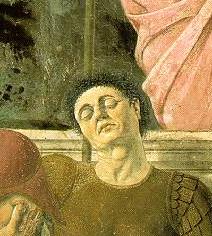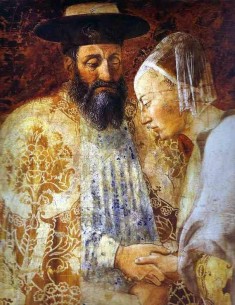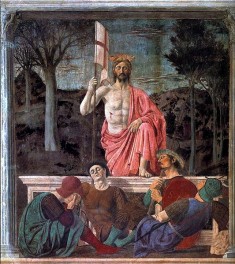| Piero della Francesca | |
|---|---|
 |
|
| Born | c. 1415 Sansepolcro, Republic of Florence |
| Died | Oct. 12, 1492 (about age 77) Sansepolcro, Republic of Florence |
| Nationality | Italian |
| Movement | Italian Renaissance |
| Field | Painting, Frescoes |
| Works | |
Piero della Francesca was an Italian Renaissance painter. Although he is most renowned for his art today, he was more famous for his work in geometry and mathematics during his lifetime. His artistic style reflects this with perspective and geometric shapes playing important roles in many of his works. Piero is best known for The Legend of the True Cross, a series of frescoes which are located in an Arezzo church near San Francesco.
Piero della Francesca’s Early Life
Piero’s birthplace was Borgo Santo Sepolcro in Tuscany. His date of birth is uncertain, but scholars agree that it was probably between 1410 and 1420. The year 1415 is commonly recognized as his birth year. Piero served in an apprenticeship to a local painter during his early years, but by the end of the 1430s he was receiving fees for his own work on a now lost church fresco in Florence. While in that city, he met renowned artists of the time, such as Brunelleschi and Donatello.
He was also inspired by the frescoes painted by Masaccio, although Piero’s consistent style throughout his life makes dating much of his work difficult. In 1445, he was commissioned to create an altarpiece for San Sepolcro’s Church of the Misericordia, a job which took him almost two decades to complete. Meanwhile, he also painted other frescoes, although most of them have been lost.
Piero’s Artistic Maturity
 By 1451, Piero was working in Rimini. While he was there, he painted a fresco of St. Sigismund that has survived to this day. He may have met the polymath Leon Battista Alberti at this time as well, although the latter generally worked only by correspondence.
By 1451, Piero was working in Rimini. While he was there, he painted a fresco of St. Sigismund that has survived to this day. He may have met the polymath Leon Battista Alberti at this time as well, although the latter generally worked only by correspondence.
After this, Piero worked in a number of towns in Italy including Bologna, Pesaro, and Ancona. After more church pieces, he moved to Rome at the behest of Pope Nicholas V where he was responsible for several more frescoes, including some in the Vatican Palace, although these have been lost to posterity.
During the 1450s, Piero went to Arezzo to complete the frescoes in San Francesco’s basilica, and this cycle – The Legend of the True Cross – is often considered his masterpiece and among of the highlights of Renaissance painting.
In 1460, the artist painted one of his best known surviving works – The Baptism of Christ – which is now in London’s National Gallery. This was intended for the high altar of a church in Sansepolcro. During the same period, he painted even more frescoes, including another in Sansepolcro depicting the resurrection of Christ, entitled Resurrection.
Piero’s Years in Urbino
From the end of the 1460s until the middle part of the 1480s, Piero often worked for the Duc d’Urbino, perhaps the most significant of all Renaissance patrons of the arts. One of his earlier works, The Flagellation, caused a great deal of controversy due to its enigmatic depiction of three men who stand in the painting’s foreground. Some art historians believe that the men are figures from the Passion of Christ, while others assert that they are more likely to have been representations of prominent personalities of Piero’s own time.
 Piero della Francesca also painted a double portrait while in Urbino which shows the duke together with Battista Sforza, his wife. The painting now hangs in the Uffizi Gallery in Florence. The couple’s heads are shown in profile after the fashion of bronze medallions and other roundels showing official portraits of the noble pair. Piero also painted the huge Montefeltro altarpiece during his time in Urbino. While there, he met several other painters, architects, and mathematicians.
Piero della Francesca also painted a double portrait while in Urbino which shows the duke together with Battista Sforza, his wife. The painting now hangs in the Uffizi Gallery in Florence. The couple’s heads are shown in profile after the fashion of bronze medallions and other roundels showing official portraits of the noble pair. Piero also painted the huge Montefeltro altarpiece during his time in Urbino. While there, he met several other painters, architects, and mathematicians.
Mathematical Work and Later Years
Piero wrote a number of mathematical works in his lifetime. These include a book on the correct use of the abacus, a short work on the Five Regular Solids, and another treatise dealing specifically with the ways of employing perspective in painting.
These pieces show a good understanding of not only geometry, but also algebra and arithmetic, with some of the work regarding solid geometry showing considerable innovations. Piero’s mathematical works were influential on some later mathematicians, in particular Luca Pacioli, who drew on Piero’s work in his classic book De Divina Proportione.
By the 1480s, Piero was becoming an old man and he was becoming weary of the constant that he enjoyed during his younger days. In 1487, two years after completing his work regarding regular geometric solids, he wrote his will, leaving his estate to the church and his relatives. He died in San Sepolcro on October 12, 1492.